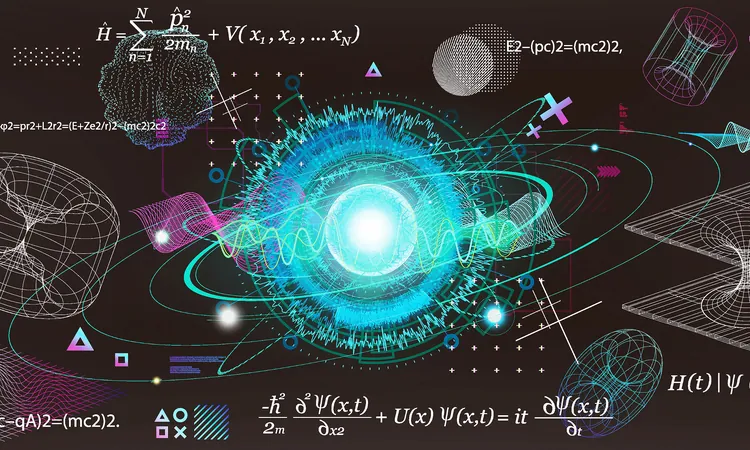
Time Takes the Lead: This New Theory May Change Everything We Know About Space
2025-06-23
Author: Jia
Unraveling the Cosmic Puzzle
The quest to harmonize space and time has long baffled physicists. The real challenge lies in merging the quantum rules that govern subatomic particles with the majestic forces shaping the cosmos. While quantum mechanics captures the minuscule, general relativity reigns over the vast—but these two theories often leave each other in the dark.
The Shift Towards Time
In an exciting twist, a new theory proposes we shift our focus from space to time itself. It suggests that our conventional understanding of time as a simple linear progression is but a glimpse into a vastly more complex reality.
Gravity: The Great Divide
Current models treat gravity as an afterthought in quantum theory, while in relativity, it's the foundation upon which everything else exists. Bridging these two perspectives is crucial—especially in extreme environments like black holes or the split-second following the Big Bang.
Introducing a Revolutionary Perspective
Enter Associate Research Professor Gunther Kletetschka from the University of Alaska Fairbanks, who asserts that the crux of the problem isn’t space but rather the way we measure time. His groundbreaking work, published in *Reports in Advances of Physical Science*, proposes a radical approach: time is not one-dimensional, but has three independent directions.
Layers of Time: A New Dimension
Kletetschka categorizes time into three layers: one governs the quantum realm, another connects this microscopic world to our everyday experiences, and the third influences cosmic structures. Our ordinary perception of time masks these additional dimensions, which only reveal their significance in extreme conditions.
Beyond Theoretical Limits
Past attempts to conceptualize three-dimensional time often fell flat, lacking tangible experimental support. Kletetschka’s model, however, aligns well with the known masses of particles, pushing this theory into the realm of testable science.
A Radical Reframing of Reality
Traditionally, particles and energy are seen as unfolding in space and time. Kletetschka flips this idea by suggesting that everything emerges from this intricate, three-layered temporal structure. If mass is merely a shadow cast by twisted time, we may finally uncover the mystery behind why particles have the masses they do.
Roadblocks and Predictions
Any good theory must take risks and propose testable predictions. Kletetschka’s theory hints at the existence of new particles that could be detected by existing accelerators, assuming they can achieve higher energies. It also anticipates shifts in gravitational wave spectra and the expansion of the universe.
The Importance of Testing
While skepticism is vital, the robustness of this theory, with its clear predictions and ability to account for existing data, sets it apart from many speculative models. The next decade will be crucial in confirming whether this revolutionary view holds water.
Why It Matters
By proposing that time holds three dimensions and viewing space as a byproduct, this theory elegantly addresses several lingering questions in modern physics. It naturally explains the existence of three particle families and provides insight into time's one-way flow without relying on hidden dimensions or hypothetical partners.
A New Era of Understanding?
Physicists are about to embark on a journey that could reshape our understanding of the universe's fundamental laws. Should Kletetschka’s ideas come to fruition, we might discover that our familiar concepts of matter and gravity are merely intricate performances on an unseen temporal stage.
The Future of Physics Awaits
As scientific instruments evolve, the next decade will likely unveil truths about gravitational waves, cosmic backgrounds, and high-energy collisions. This enduring curiosity about the nature of time and space encourages us to consider the wonders that lie hidden beyond our current comprehension.


 Brasil (PT)
Brasil (PT)
 Canada (EN)
Canada (EN)
 Chile (ES)
Chile (ES)
 Česko (CS)
Česko (CS)
 대한민국 (KO)
대한민국 (KO)
 España (ES)
España (ES)
 France (FR)
France (FR)
 Hong Kong (EN)
Hong Kong (EN)
 Italia (IT)
Italia (IT)
 日本 (JA)
日本 (JA)
 Magyarország (HU)
Magyarország (HU)
 Norge (NO)
Norge (NO)
 Polska (PL)
Polska (PL)
 Schweiz (DE)
Schweiz (DE)
 Singapore (EN)
Singapore (EN)
 Sverige (SV)
Sverige (SV)
 Suomi (FI)
Suomi (FI)
 Türkiye (TR)
Türkiye (TR)
 الإمارات العربية المتحدة (AR)
الإمارات العربية المتحدة (AR)